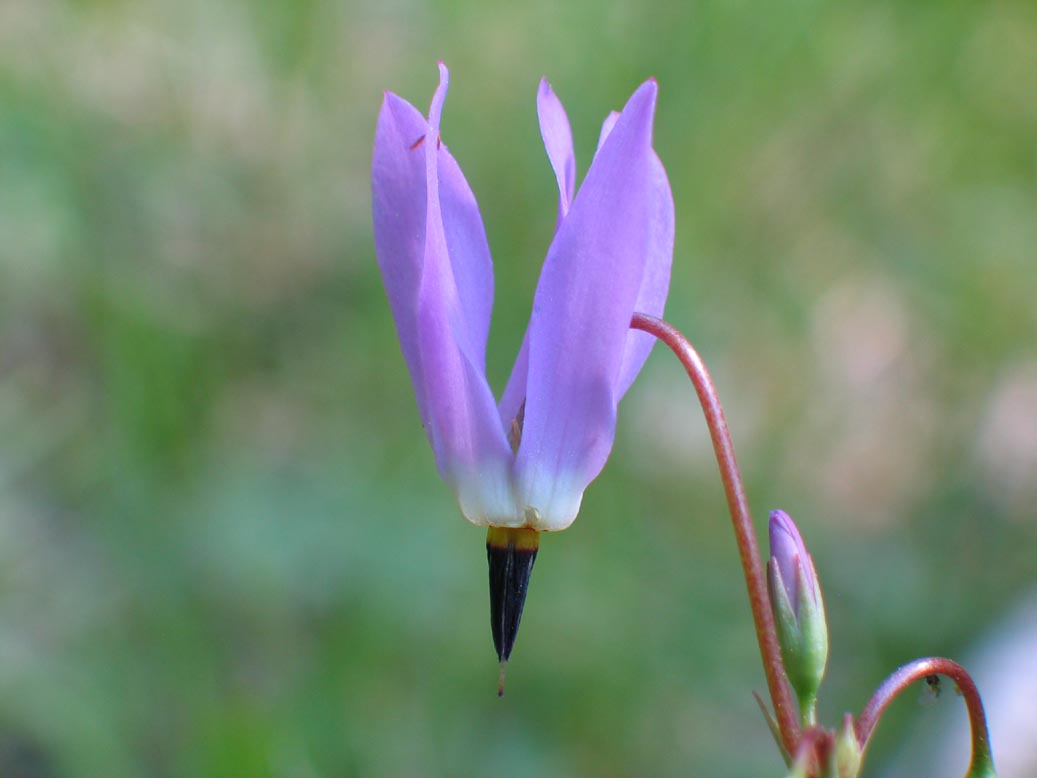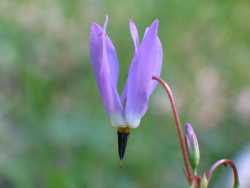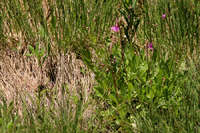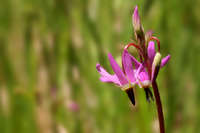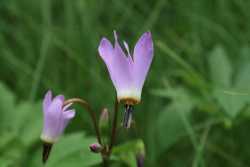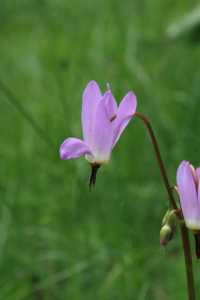Plants (2-)10-45(-60) cm; scape usually glabrous, sometimes glandular-pubescent or -puberulent. Caudices not obvious at anthesis; roots white; bulblets absent. Leaves (2-)4-25(-48) × 0.3-6(-8.5) cm; petiole ± winged, sometimes wingless near base; blade oblanceolate to spatulate or ovate to nearly oval, base decurrent onto stem, usually gradually tapering to petiole, margins usually entire, rarely slightly toothed, sometimes undulate, surfaces glabrous or glandular-pubescent. Inflorescences 2-15(-22)-flowered; bracts lanceolate, 2-15 mm, glabrous or glandular-pubescent or -puberulent. Pedicels (0.7-)1-5(-7) cm, glabrous or glandular-pubescent or -puberulent. Flowers: calyx green, usually purple-flecked, 4-8 mm, glabrous or glandular-pubescent or -puberulent, tube 1.5-4 mm, lobes 5, 1-6 mm; corolla tube maroon or yellow (fading to white) with reddish to magenta, thin, wavy ring, ring rarely absent, lobes 5, usually magenta to lavender, rarely white, (5-)7-20 mm; filaments connate, tube yellow or maroon to dark purple or black, 0.7-3.6 × 1-3 mm; anthers 3-8.5 mm; pollen sacs dark maroon to black (at least apically) or yellow (at least apically), usually with some pink, reddish, or maroon speckles or lines dorsally, connective maroon to black or yellow, smooth or longitudinally wrinkled; stigma not enlarged compared to style. Capsules tan to light brown, often reddish brown apically, sometimes speckled with red or maroon, valvate, cylindric-ovoid, 5-14(-20) × 3-5(-7) mm, glabrous or glandular-pubescent; walls thin, pliable. Seeds without membrane along edges.
The variation within Dodecatheon pulchellum is substantial and, for the most part, each of the entities recognized here seems distinct although nearly all break down in one or more features; most seem to have intergraded with other entities in the past. Variety pulchellum is the most widespread and remains, even as treated here, quite variable. The depauperate, often uniflorous, high-elevation form, var. watsonii, is included in var. pulchellum; there is no difference except in overall size even on the East Humboldt and Ruby mountains of northeastern Nevada, the type location of var. watsonii. Widely disjunct populations assigned to var. monanthum remain problematic. The plants of northwestern California and southwestern Oregon differ only slightly from those found elsewhere in Oregon, including the Blue Mountains, where the type of var. monanthum was obtained. The southern Utah expression, while similar morphologically, displays a biogeographic pattern that is unique. A better understanding of the variation between the western and eastern phases of var. monanthum is needed.
The coastal var. macrocarpum has consistent morphological differences and a higher ploidy level (2n = 88, 132) compared with the more inland var. pulchellum (2n = 44). Whether or not the ploidy level difference is consistent remains to be shown.
The arid forms of Dodecatheon pulchellum exhibit remarkable morphological differences that require recognition (J. L. Reveal 2005). Hanging garden plants in Utah are recognized as var. zionense, following N. H. Holmgren (2005). Some populations assigned to this variety may ultimately prove to be merely large-leaved plants of either var. pulchellum or the Utah phase of var. monanthum. Zion shootingstar may owe both its large leaves and its glandular-puberulent pedicels and calyces to hybridization with D. redolens sometime in its evolutionary past, even though the latter taxon is no longer close geographically. Variety shoshonense, usually growing in moist, alkaline meadows, is found mainly in the northern Mojave Desert and the Intermountain West. The color pattern associated with the stamens differs from most other varieties of the species, suggesting a fundamental change associated with pollination and likely a closer relationship to var. cusickii (which also has yellow pollen sacs) than to var. pulchellum.
This taxon inadvertently was named Dodecatheon puberulum (Nuttall) Nuttall three years before the establishment of Exinia pulchella. To avoid nomenclatural disruptions, the basionym D. meadia var. puberulum Nuttall has been proposed for rejection (J. L. Reveal and K. N. Gandhi 2008).
Much like no. 1 [Dodecatheon meadia L.], but usually smaller and blooming 2 weeks later; lvs not tinged with red toward the base; cor-lobes mostly deep rose-purple, rarely white, averaging smaller than in no. 1; fr thickest near the middle, the walls thin and fragile; 2n=44. Moist hillsides; driftless area of sw. Wis. and adj. Minn. to nw. Ill.; irregularly from e. Mo. to Pa., s. of the glacial border; throughout the w. cordillera. Apr.-June. Our plants are var. radicatum. (D. amethystinum)
Gleason, Henry A. & Cronquist, Arthur J. 1991. Manual of vascular plants of northeastern United States and adjacent Canada. lxxv + 910 pp.
©The New York Botanical Garden. All rights reserved. Used by permission.
PLANT: 15-40 cm tall.
LEAVES: oblanceolate to elliptic, the margins entire to slightly dentate, crenate, or sinuate.
FLOWERS: pink to purple; calyx 5.3-8.2 mm long, the lobes 5; corolla (reflexed portion) 13-20 mm long, the lobes 5; stamens 5, the filaments (1-)1.5-2 mm long; stigma not much wider than the style. 2n = 44, 88.
NOTES: 3 subspp.; s AK and Can. s to Mex. and in e US s to AR.


